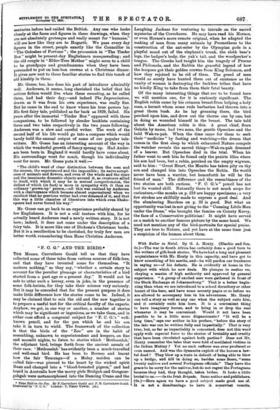" F. C. G." AND THE BIRDS.* THE Messrs. Carruthers
Gould tell us that they have collected some of these tales from various sources of folk-lore, and that they have invented some for themselves. "It matters nothing," so they say, " whether a certain story to account for the peculiar plumage or characteristics of a bird started from a past age or a present day." It would not be safe to utter such a heresy, even in joke, in the presence of some folk-lorists, for they take their science very seriously. But it may be conceded that for the present purpose it does make little difference how the stories come to be. Indeed, it may be claimed that to mix the old and the new together is to prepare a useful test for the critical faculty of the experts. Anyhow, we get, in one way or another, a number of stories which may be significant or ingenious, as we take them, and in either case afford a congenial subject for " F. C. G.'s " well- known pencil, and for the pen which he and his son take it in turn to wield. The framework of the collection is that the birds of the " Zoo" are in the habit of assembling, unknown to superintendent and keepers, on fine and moonlit nights, to listen to stories which Methuselah,' the adjutant bird, brings forth from the ancient annals of their race. Methuselah' has evidently been a much-travelled and well-read bird. He has been to Borneo and learnt how the fair Temunga—if a Malay. maiden can be called fair—was pierced to the heart by the wicked spirit Bnan and changed into a "blood-breasted pigeon," and had heard in Australia how the merry girls Bralgah and Gougour- gahgah were metamorphosed into the Dancing Crane and the
• Tales Told in the Zoo. By F. Carruthers Gould and F. H. Carruthers Gould. Illustrated by F. C. G." Loudon ; T. Fisher Uuwin. [ee.]
Laughing Jackass for venturing to intrude on the sacred mysteries of the Corroboree. He may have read his Horace, or even Horace's more remote original, when he adapted the making of man from many animals by Prometheus to the construction of the ant-eater by the Olympian gods in a playful mood out of the elephant's trunk, the sloth bear's legs, the badger's body, the yak's tail, and the woodpecker's tongue. The Greeks had taught him the tragedy of Procne and Philomela, and the Rabbis the graceful legend of how the hoopoes got their golden crowns from King Solomon, and how they rejoiced to be rid of them. The greed of men would as surely have hunted them out of existence as the vanity of woman is destroying the luckless tribes that have no kindly King to take from them their fatal beauty.
Of the many interesting things that are to be found here we will mention one, for it is curiously significant. The English robin came by his crimson breast from helping a holy man, a hermit whom some rude barbarian had thrown into a great thorn bush. As he lay groaning there, the bird perched upon him, and drew out the thorns one by one, but in doing so wounded himself in the breast. The tale told about the American robin is this. A great chief, Scan Gelatin by name, had two sons, the gentle Opeechee and the bold Wah-ra-pah. When the time came for them to seek their "medicine " by fasting and watching—the dream that comes in the first sleep to which exhausted Nature compels the watcher reveals the sacred thing—Wah-ra-pah dreamed of a beaver. But Opeechee died in the trial. When hie father went to seek him he found only the prairie lilies where his son had been, but a robin, perched on the empty wigwam, said to him : " Great Heart, the Manito has taken pity on thy son and changed him into Opeechee the Robin. He would never have been a warrior, but henceforth he will be the friend of man." The difference and the resemblance of the two stories are both curious. " F. C. G.'s " pencil has not lost its wonted skill. Naturally there is not much scope for caricature,—the monks on p. 219 are happy specimens ; a very few strokes are skilfully made to express a good deal. And the slumbering Bacchus on p. 23 is good. But what an opportunity was lost in not giving to the " Cunning Little Man under the Stone," who brought the famine on County Kerry, the face of a Conservative politician! It might have served as a match to another famous picture by the same hand. We need not mention any of the bird-portraits for special praise. They are true to Nature, and yet have at the same time just a suspicion of the human about them.






















































 Previous page
Previous page